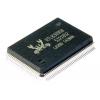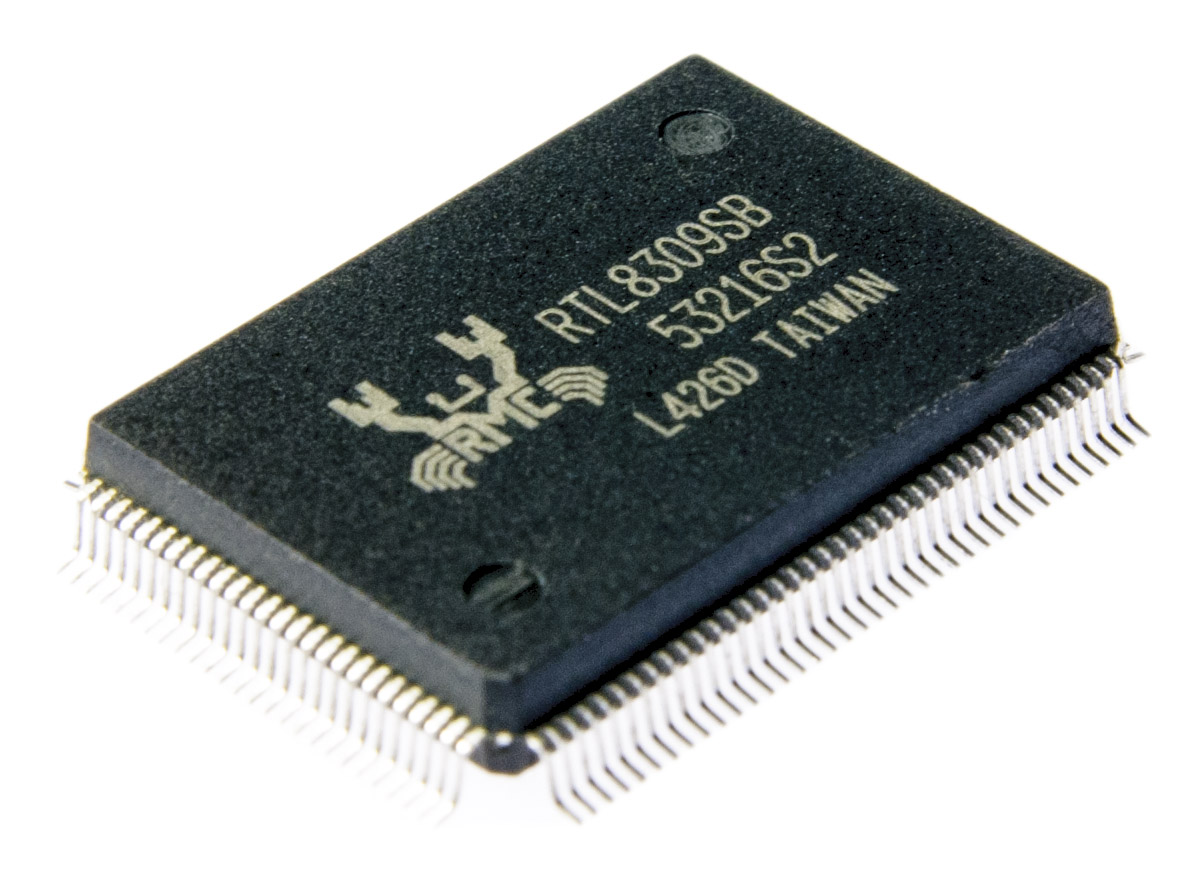-
zł

Overview
The RTL8309SB is a 128-pin, ultra-low-power, high-performance 8-port Fast Ethernet single-chip switch with one extra MII port for specific applications. It integrates all the functions of a high speed switch system—including SRAM for packet buffering, non-blocking switch fabric, address management, one general use MII interface, eight 10/100Base-TX transceivers, and nine Media Access Controllers—into a single 0.18μm CMOS device. It provides compatibility with all industry standard Ethernet and Fast Ethernet devices. Only a 25MHz crystal is required; the EEPROM is optional to save BOM costs. The embedded packet storage SRAM in the RTL8309SB features superior memory management technology to efficiently utilize the memory space. An integrated 1024-entry look-up table stores MAC address and associated information in a 10-bit direct mapping scheme. The table provides read/write access from the SMI interface, and each of the entries can be configured as a static entry. A static entry indicates that this entry is controlled by the external management processor and automatic aging and learning of the entry will not take place. To prevent MAC address mapping collisions, the embedded 16-entry Content-Addressable Memory (CAM) offers another memory space for recording the MAC address when the mapped entry in the lookup table is occupied. For each incoming packet, the RTL8309SB searches the entries in the lookup table and the 16-entry CAM simultaneously. Then it obtains the correct destination port information to determine which output port the packet should be forwarded to. The aging time of the RTL8309SB is around 300 seconds (this may be sped up to 800μs via EEPROM configuration). The ninth port of the RTL8309SB implements a MAC module without a PHY transceiver to provide an MII interface for connection with an external PHY or MAC in specific applications. This MII interface may be set to MII PHY mode, SNI PHY mode, or MII MAC mode to work with an external MAC module in a routing engine application, PHY module in a HomePNA application, or other physical layer transceivers. In order to operate correctly, both sides of the connection must be configured to the same speed, duplex, and flow control settings. Four pins are used for the ninth port to force the link status. This interface should be 2.5V or 3.3V compatible depending on the voltage supplied to the power pin VDDIO of this interface. The RTL8309SB is capable of preventing broadcast storms by setting strapping pins upon system reset. When this function is enabled, it will drop broadcast packets after receiving 64 continuous broadcast packets. This counter will be reset to 0 every 800ms or when the RTL8309SB receives a non-broadcast packet. The RTL8309SB displays the port status via fourLED indicators (with optional blinking time setting). These LEDs blink for diagnostic purposes at system reset time. The RTL8309SB provides various type of RTL8309SB Datasheet Single-Chip 9-Port 10/100Mbps Switch Controller 2 Track ID: JATR-1076-21 Rev. 1.6LED combinations to fit different applications. Eight combinations of link, activity, speed, duplex, and collision, are available. Bi-color LED mode is also supported on the Link/Act LED. The RTL8309SB supports standard 802.3x flow control frames for full duplex, and optional backpressure for half duplex. It determines when to invoke the flow control mechanism by checking the availability of system resources, including the packet buffers and transmitting queues. If one of the forwarding ports is blocked, or system resources are unavailable, broadcast frames will be dropped according to the system configuration. The RTL8309SB support two types of dropping methods. The input dropping method will not forward broadcast packets to any output ports and will drop these packets directly. The output dropping methodwill forward broadcast packets to non-blocked ports only. To improve real-time and multimedia networking applications, the RTL8309SB supports four types of QoS (Quality of Service). These are based on (1) Port-based priority, (2) 802.1p/Q VLAN priority tag, (3) TOS field in IPv4 header, (4) Specific IP address. Each output port supports a weighted ratio of high-priority and low-priority queues to fit bandwidth requirements in different applications. The RTL8309SB provides 802.1Q port-based VLAN operation to separate logical connectivity from physical connectivity. Each port may be set to any topology via EEPROM upon reset or SMI after reset. The RTL8309SB also provides options to meet special application requirements. The first option is the ARP VLAN function, which is used to select to broadcast ARP frames to all VLANs or only forward ARP frames to the originating VLAN. The second option is the Leaky VLAN function, which is used to select to send unicast frames to other VLANs or only forward unicast frames to the originating VLAN. The VLAN tags can be inserted or removed on a per-port basis. In router applications, the router may want to know which input port this packet came from. The RTL8309SB supports Port VID (PVID) for each port to insert a PVID in the VLAN tag on egress. In this function, the VID information carried in the VLAN tag will be changed to PVID. The RTL8309SB also provides an option to admit VLAN tagged packet with a specific PVID only. If this function is enabled, it will drop non-tagged packets and packets with an incorrect PVID. Each physical layer channel consists of a 4B5B encoder/decoder, Manchester encoder/decoder, transmit output driver, scrambler/descrambler, output wave shaping, filters, digital adaptive equalizer, PLL circuit, and DC restoration circuit for clock/data recovery. This integrated chip benefits from low power consumption and offersadvanced functions with flexible configuration for a small workgroup switch, multimedia, or real-time traffic mixed with other data type traffic, and other applications.
Features
- Integrates eight 10/100 transceivers and nine MAC units for 10Base-T and 100Base-TX.
- Embedded SRAM for packet storage.
- On-chip 1024-entry look-up table in direct mapping mode.
- Embedded 16-entry CAM for hash collision mapping.
- Provides read/write access to look-up table entries via SMI interface.
- Provides non-blocking wire speed reception and transmission.
- Flow control fully supported:
- Half-duplex: backpressure flow control.
- Full-duplex: IEEE 802.3x flow control.
- Support for 4 LEDs per-port in various combinations for comprehensive applications. Optional loop detection function with an LED to indicate the existence of a loop.
- LEDs blink upon reset for LED diagnostics.
- Flexible system configuration by strapping pins, EEPROM, or SMI interface.
- Optional crossover detection and auto correction for plug-and-play.
- Fully compliant with IEEE 802.3/802.3u. Optional Forwarding/Filtering reserved control frames (DID= 0180C2000003~0180C200000F).
- Optional Broadcast Input/Output Drop flow control.
- Optional maximum packet length 1536/1552 Bytes.
- Supports two Power Reduction methods:
- Power saving mode (automatic cable detection).
- Power down mode (via PHY register 0.11).
- Supports QoS function:
- QoS based on: (1) Port-based priority (2) 802.1p VLAN tag (3) DiffServ/TOS field in TCP/IP header (4) IP address.
- Supports two-level priority queues with various weighting ratios.
- Queue service rate based on weighted round robin algorithm.
- Optional auto turn off Flow Control for 1~2 sec to avoid head-of-line blocking.
- Supports MII interface connection to external MAC or PHY via 3 modes.
- PHY mode MII for router applications.
- PHY mode SNI for router applications.
- MAC mode MII for HomePNA or other PHY applications.
- Flexible 802.1Q port/tag-based VLAN.
- Optional 802.1Q tag-VID aware function.
- Optional VLAN Ingress Tag Admit Control.
- Optional VLAN Ingress Member set filtering.
- Optional ARP VLAN for broadcast packet.
- Optional Leaky VLAN for unicast packet.
- Optional 802.1P/Q tag insertion or removal on per-port basis (egress).
- 25MHz crystal input. 0.18μm, CMOS technology.
- 128-pin PQFP package. 1.8V core voltage.
- Independent power options for 2.5V or 3.3V MII interface.






 Polski
Polski English
English Italiano
Italiano Español
Español Čeština
Čeština Српски
Српски Deutsch
Deutsch Ελληνικά
Ελληνικά Slovenský
Slovenský




